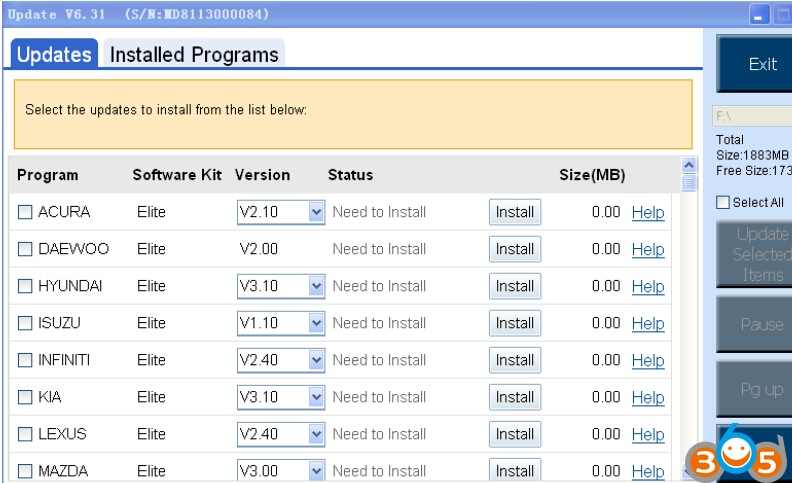
Honda Hds Software Crack Website
Here’s how to reprogram your odometer after an instrument cluster swap. The vehicle this was demonstrated on is a 2004 Honda Accord. YouTube Video: DIY Honda Odometer Reprogramming Disclaimer: 1. The information provided should only be used to correct mileage information. While it is not illegal to change your odometer reading, it is illegal to falsify or misrepresent the actual mileage of the vehicle.
The odometer display can be just as easily changed by swapping clusters to one of a lower mileage. This procedure requires disassembly of the cluster, and de-soldering of SMD components. Use care and caution when dealing with delicate components, and practice first on a spare cluster. Let’s say you swapped an instrument cluster from a coupe to a sedan to change the look or color of the needles, or you’re replacing a defective cluster. The mileage on most (Japanese) cars is stored on the instrument cluster itself, and not in the ECU. Therefore the mileage of the original vehicle that the cluster was from will be displayed on the dash. Odometer information is stored on a small EEPROM chip on the circuit board.
Top selling honda obd2 software is a great quality product - buy now and save big! Find more similar products like the honda obd2 software here at wholesale price. Obd2-diagnostic.com offers the very best in selection, comfort and affordability. Honda HDS 3.015 + ECU Rewrite 6.27. Brand:Honda Product Code: Honda Availability: In Stock Quantity: 01. Features: DTC reading and clearing Snapshot function (capture data relative to a trigger event) Vehicle data display (value, line graph, bar graph formats) DLC locator diagrams Data.
 • There is now first-class support for all the latest tech. • You can perform unit testing with the help of this IDE.
• There is now first-class support for all the latest tech. • You can perform unit testing with the help of this IDE.
The chip can be read and written to using a serial programmer. The information is coded in HEX characters.
The odometer information can be copied over from the old cluster to the new cluster using Honda HDS, assuming the original cluster is operable. What follows is a hack-around to using HDS, by programming the mileage directly to the chip. You can also opt to merely swap the chips, or copy and paste the program, rather than decode.' ' Tools and Parts Required: • Screwdrivers • Soldering iron, solder and a de-soldering pump • Computer with Windows XP and serial port • 8 pin DIP socket • Serial programmer - Breadboard - Hookup wire - Female serial port header - 5V from computer power supply - 4.7K ohm resistors - 5V Zener diodes o Wire strippers • Serial programming software (PonyProg freeware) • A spare instrument cluster in case you screw up Here's the original instrument cluster from my LX sedan, 314,622 km, and here’s my new cluster. It’s from an EX-L sedan with 211,150km.
Once the cluster is out of the vehicle, pull up on a few tabs to remove the front plastic cover and fascia. The needles will need to come off next. Pull up on them carefully and they’ll come out. Take a photo of their home position before taking this apart so you know where to realign it upon reassembly.
Use gloves and don’t touch the black face of the gauges, it’s a fingerprint magnet. Once the gauge face is removed, remove the white backing plate revealing the circuit board, with the L56 EEPROM chip.
This is the EEPROM programmer I built to connect the chip to my desktop computer. It interfaces through the RS232 serial port. All it is are three 5V zener diodes ($1) and three 4.7K ohm resistors ($1).
The rest is some 22 AWG hookup wire and a breadboard ($5). And here’s my programmer connected to the PC.
And the breadboard with the resistors and diodes. Now here’s where it got tricky. Using the PonyProg software, I was able to read and save the information from the odometer chip. But I wasn’t able to write to the chip.
The EEPROM must be removed from the board if you want to write to it, as it can’t be programmed in circuit. So off we went trying to desolder an SMD chip And SNAP!!! The leads broke off the chip. This is why you should use a hot air station so it heats all the pads evenly and you can just pick the chip off the board instead of prying it. Luckily, I had saved the EEPROM information I downloaded earlier. I found another replacement chip, the Microwire 93C56 chip from a car’s ECU I had laying around.
The 93C56 chip is identical electronically to the L56 chip. So I soldered wires to the “new” chip, and was able to connect it to the programmer directly, without having the board hamper the write function. The additional advantage is I could now quickly disconnect and reconnect my chip to the odometer board, and then test my new program out on the car as I decoded the odometer program. I used PonyProg software, which is a free serial device programmer. It reads and writes to the COM port, which in my case is directly to the chip. If you don’t have a serial port on your computer, you can purchase an EEPROM programmer that connects via USB and emulates a serial port. First thing, head over to the setup menu under options; Make sure its set to read from the serial port, COM1, and SI Prog I/O.